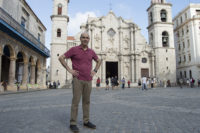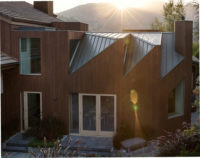Newsmaker: Geoffrey Croft

|
|
Photo © Natasha Vakulenko
Geoffrey Croft surveys a mess in Idlewild Park in Queens, New York.
|
Raised in the Bronx and in Manhattan’s Yorkville neighborhood, Croft was volunteering in the late1980s with photography and roller hockey programs at Stanley M. Isaacs Park on Manhattan’s Upper East Side and was horrified to discover—a few blocks from Gracie Mansion, the official residence of New York City’s mayors—a splintering skating rink and restrooms littered with crack vials. That’s when Croft formed his first nonprofit, raising $200,000 to renovate the park. Later, as a contract employee for the Parks Council (now New Yorkers for Parks) and after founding NYC Park Advocates, Croft undertook to personally survey the condition of each of more than 4,000 city, state, and federal parks in the five boroughs. He hasn’t slowed down since.
Architectural Record: NYC Park Advocates has had many successes in helping prevent private development on public parkland. What’s the latest?
We organized a lawsuit that was just settled in December regarding Damrosch Park [a 2.4- acre park with a band shell] near Lincoln Center. Former Mayor Michael Bloomberg had given carte blanche to Lincoln Center to rent out the park 10 months a year. As a result of the suit, Lincoln Center’s ability to rent out the park will be dramatically curtailed. They also have to restore gardens by the famous landscape architect Dan Kiley, including 57 trees that were cut down. Fashion Week got the most attention, but the park was also rented out for corporate events, weddings, and bar mitzvahs. People didn’t even realize it was a public park! They took down all the Parks Department signs, which was pretty outrageous. The Big Apple Circus is still there, but we’re trying to figure out a way for it to take up less space.
Geoffrey Croft: Your group was among the plaintiffs in a prolonged lawsuit over land use in Union Square Park. How is that turning out?
Saving Union Square [from private development] has been an eight-year campaign. A private Business Improvement District hired [landscape architect] Michael Van Valkenburgh to design a playground at the north end of the park, and the community had zero say in the design. It captured only a small amount of additional space in a neighborhood that has the least amount of playground space in the entire city. They were forced to redesign it. The BID also had a plan to put a permanent restaurant in a 1930s pavilion that has been a backdrop for social protests and community activities for almost 100 years. We’re still trying to figure that out. We knocked out the year-round restaurant [a seasonal restaurant operated last year from May to October] and we are waiting to hear from the Mayor’s office whether the pavilion will revert to use by arts and community groups rather than as a high-end restaurant in an area that already has a high concentration of bars and restaurants.
NYC Park Advocates is also involved in a fight over land use in Queens’ flagship park, Flushing Meadows-Corona Park.
We’re trying to stop the expansion of the U.S. Tennis Association Tennis Center in Flushing Meadows-Corona Park, but our elected officials have made a deal which allows them to expand. [The USTA plans to build two new stadiums and two parking garages on 42 acres currently leased from the Parks Department.] They’re in the process of cutting down 400 trees. And we just filed an appeal last week to protect that park from yet another example of irresponsible development. The Related Companies, which is building Hudson Yards, was given a billion-dollar piece of parkland to build the largest shopping mall in New York City, which will not only displace local mom and pop stores, but take away 47 acres of public parkland.
How have things changed since Bloomberg and Adrian Benepe [former NYC Parks Commissioner] went out, and Mayor Bill de Blasio and Mitchell J. Silver [current NYC Parks Commissioner] came in?
They haven’t, really. The main difference is that this administration has gone on record as recognizing there is a huge disparity in funding between parks, and that this is something they want to address. But the recent budget de Blasio released—less than one-half of 1 percent of the $75 billion budget for an agency responsible for 14 percent of the city’s land—is further evidence that parks are not a priority. That is one-third of the money that’s needed. This administration has said it wants the public-private partnerships, or conservancies, to help out other parks, but the vast majority of conservancies don’t have enough money to take care of their own parks, so it will have very little impact. Several hundred parks have some sort of “Friends of” group helping them out, but we need elected officials to allocate proper funds and not depend on private funds to make up the shortfall.
Your website says NYC Park Advocates wants park services delivered based not on a community’s ability to raise private funds, but on the principle that all neighborhoods deserve equitable treatment.
The disparity between neighborhoods has been accentuated in recent years by the rise of public-private partnerships. There’s $57 million available annually to care for Central Park [843 acres], but the entire Bronx has half that for more than 7,000 acres. Central Park has 26 people to maintain their ball fields, whereas the rest of the city doesn’t have a single crew for more than 600 ball fields. They’re dustbowls in summer and wetlands when it rains.
Where does the money come from for all the legal representation required by your group’s activities?
Some of it is pro bono, but most is hired. I raise funds, and we have partnerships with other groups. Union Square alone cost hundreds of thousands of dollars in legal fees. The Union Square Community Coalition, one of the oldest park nonprofits in New York City, was very helpful. At Lincoln Center, it was the Committee for Environmentally Sound Development. They reached out to their members for donations, and are still raising money to pay off the legal fees. It’s incredible that the city puts its citizenry in a position to have to raise funds to sue them for things that should be the city’s role and responsibility.
Are there lessons for other cities in what NYC Park Advocates is doing?
We’ve been getting calls from all over the country—schools, environmentalists, other municipalities—about removing artificial turf. Because the city refused to allocate money to maintain ball fields, they put in infill made from recycled tires that contains dozens of chemicals, including some known carcinogens. We were instrumental in getting the city to stop doing this. But the main lesson is to hold elected officials and people in charge of what is supposed to be public space accountable, and get the government to do its job.


